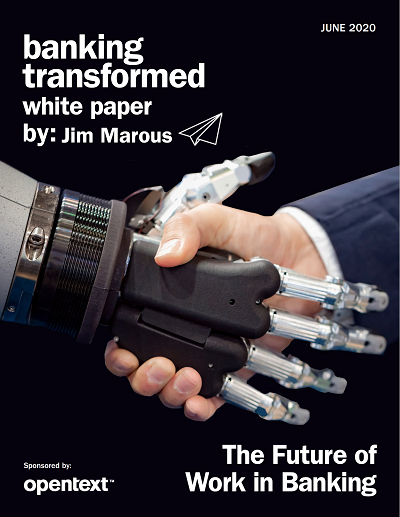The Future of Work in Banking
Special Report
Jim Marous
June 2020
: DBR 269
21 pages, 11 tables/charts
Download Printable Version of this page
It is increasingly clear that the entire banking ecosystem and the way consumers interact with financial organizations have been shaken to the core as a result of COVID-19. We will look back on this period as a tipping point between the period before COVID-19 and the ‘new normal’ that emerges in the post-coronavirus era.
In much of the pre-COVID-19 research conducted by the Digital Banking Report around digital transformation, customer experience, use of data and advanced analytics, innovation and technology, it was clear that industry leaders knew what needed to be done, and in many cases, how to proceed. There just was not the urgency to take action since we were in prosperous times. Everything changed with COVID-19.
In the ‘new normal’ period, we have witnessed an environment where the way work is completed, how consumers bank, how employees learn new skills and how brands are perceived are all different. The degree to which these changes take root will be driven by both business and societal dynamics as well as how long it takes to move to a new equilibrium.
The discussion about working from home for most banking employees was just that – a discussion. At best, it was an exception allowed for a few due to illness or for those who were associated with outside sales. Usually, requests to work from home were dismissed out of concern for lost productivity. When COVID-19 hit, working from home became a necessity for almost everyone.
While the initial 7 – 10 days was anything but smooth, most workers who never had experienced the challenges of working with an entire family at home settled into a routine. New equipment was purchased, new working environments were created, and new work schedules were set (balancing work and family needs).
As we look to the future, some workers will return to the traditional office when the coronavirus crisis subsides. But many will not. Offices will not die out completely. But the notion of spending extended hours there each week most likely has ended. As the coronavirus hit – the office became an ancillary casualty.
Why would banking, or any industry, move backwards once the potential for digital transformation has been realized? Why would a financial institution require a customer to visit a branch to complete an account opening or loan application? Why wouldn’t organizations move forward in the collaboration of humans enhanced by advanced technology?
While nobody can be certain about what the post-coronavirus world will look like, there is one reality that has been proven without a doubt. Change has happened in an instant. The key is to imagine possible outcomes and set in motion those initiatives that can position your organization most advantageously. The following are most likely outcomes:
- Being ‘digital’ is not optional
- Working remotely will become much more common
- Innovation across all functionalities is an imperative
- Personal and professional development will prepare employees for future changes
- Sustainability will be valued by consumers, employees and shareholders
Financial institutions that move quickly and decisively to embrace new future of work realities as a result of COVID-19 are best positioned to succeed in the future. This includes new work environments, new ways to collaborate, new digital skill sets and new methods of leveraging technology to augment human capabilities.
The Future of Work in Banking
Advanced Analytics, AI, Analytics, Artificial Intelligence, Bank, Banking, Big Data, Branches, Coronavirus, COVID-19, Credit Union, CRM, Customer Experience, CX, Digital Banking, Digital Lending, Digital Marketing, Digital Transformation, Engagement, Experience, Finance, Fintech, Future of Work, Innovation, Lending, Marketing, Mobile Banking, Payments, Personalization, Retail Banking, Technology, Trends, User Experience

